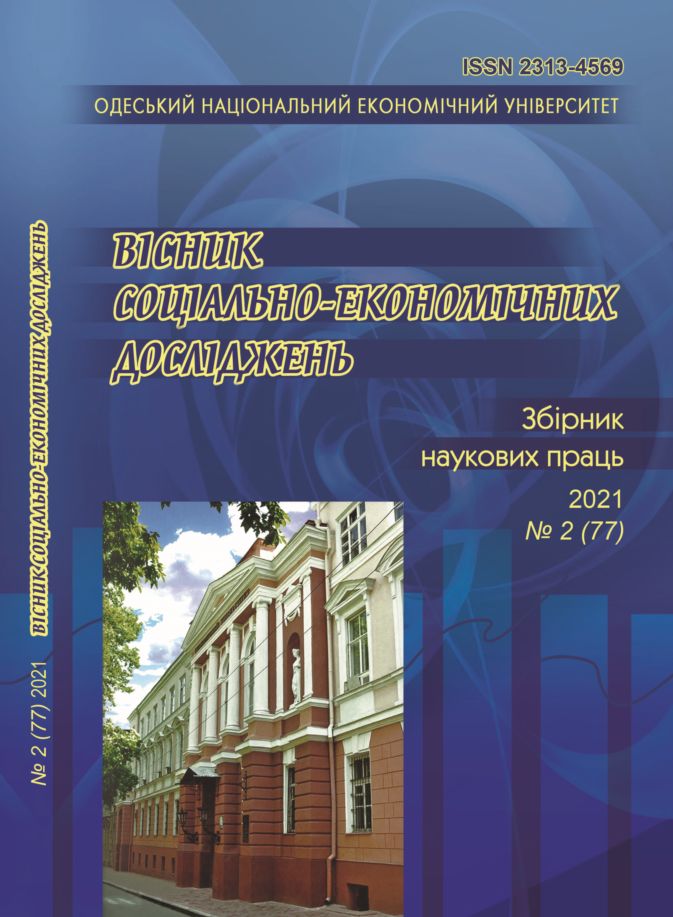World ratings: features of formation and impact on the on the country’s economic growth
DOI:
https://doi.org/10.33987/vsed.2(77).2021.181-192Keywords:
international ratings, rankings, rating agencies, credit rating, Moody’s Investors Service, Standard & Poor’s, FitchAbstract
The article investigates the ratings formation as a special type of activity that is actively implemented in a market economy. The process of creating a rating system is considered. It is established that the analysis results of economic entities activities are expressed as the results of evaluation in the rating scale. The main difference between the concepts of «rating» and «ranking» is determined, which allows building economic entities according to the ranking, that is, according to one of the indicators. The criteria that underlie the classification of ratings are analyzed. It is noted that in the economic literature, in most cases, it is carried out by rating agencies and companies. It is established that the rating process, as a business, has not only a methodological, but also a certain moral component. The regulatory element of rating agencies and features of their national and international rating scales are studied. A set (system) of national rating scales are determined, which provides the most complete and objective assessment of the issuer’s creditworthiness. The ratings of international rating agencies, which are assigned, usually, on two scales: international and national, are studied. It has been proven that changes in ratings play an important role for transactions with interest rate risks, as information for investors in decision making. The main methods of rating are established, which are largely closed. The leading credit ratings of international agencies, which are used by portfolio investors in decision-making, including country and regional ratings, are named. The main advantages that provide credibility to the ratings are substantiated, such as: the agency’s reputation; the agency has a generally recognized and accessible reporting methodology; differences in approaches to the analysis of rating subjects.
References
Parkhomenko, N. O. (2020). Influence of tendencies of global environment development on business systems activity [Vplyv tendentsii rozvytku hlobalnoho seredovyshcha na diialnist biznes-system], Visnyk Kharkivskoho natsionalnoho universytetu im. V. N. Karazina, Seriia «Mizhnarodni vidnosyny. Ekonomika. Kraieznavstvo. Turizm», No. 12, s. 59–68. DOI: https://doi.org/10.26565/2310-9513-2020-12-05 [in Ukrainian]
Semenog, A. Yu. (2020). Analysis of world ratings for assessing the formation and development of the digital economy and Ukraine’s place in them [Analiz svitovykh reitynhiv otsinky formuvannia ta rozvytku tsyfrovoi ekonomiky ta mistse Ukrainy v nykh], Naukovyi visnyk Mizhnarodnoho humanitarnoho universytetu, Seriia: Ekonomika i menedzhment, No. 43, s. 38–43. DOI: https://doi.org/10.32841/2413-2675/2020-43-6 [in Ukrainian]
Plastun, O. L., Dudkin, O. V. (2012). International investment ratings as a means of eliminating information asymmetry at the macroeconomic level [Mizhnarodni investytsiini reitynhy yak zasib usunennia informatsiinoi asymetrii na makroekonomichnomu rivni], Marketynh i menedzhment innovatsii, No. 3, s. 191–198 [in Ukrainian]
Pisarenko, T. V., Kuranda, T. K., Kochetkova, O. P., Muratova, N. I. (2014). Ecological condition of Ukraine according to indicators of international ratings and results of monitoring of realization of scientific and technical priorities [Ekolohichnyi stan Ukrainy za pokaznykamy mizhnarodnykh reitynhiv i rezultatamy monitorynhu realizatsii naukovo-tekhnichnykh priorytetiv], Scientific and technical information, No. 2, s. 10–17 [in Ukrainian]
Makara, O. V. (2007). Competitiveness of the economic environment in Ukraine. Comparative analysis of individual countries ratings [Konkurentospromozhnist ekonomichnoho seredovyshcha v Ukraini. Porivnialnyi analiz reitynhiv okremykh krain]. Retrieved from: http://www.eip.org.ua/docs/ EP_07_2_43_uk.pdf [in Ukrainian]
Кarminskiy, A. M. (2010). Models of corporate credit ratings [Modeli korporativnykh kreditnykh reytingov], Preprynt # WP 2009/Х R, Rossiyskaya ekonomicheskaya shkola Moskva, 39 s. Retrieved from: https://www.nes.ru/files/old-nes/programs/econ/ preprints/2010/Karminsky_2010.pdf [in Russian]
Ukraine’s position in international rankings in the field of industry [Pozytsii Ukrainy v mizhnarodnykh reitynhakh u sferi promyslovosti], Industry 4.0 – Platform INDUSTRY4UKRAINE. Retrieved from: https://www.industry4ukraine.net/#about [in Ukrainian]
Ranking of countries by the level of ease of doing business [Reitynh krain za rivnem lehkosti vedennia biznesu], The World Bank Group: website. Retrieved from: https://www.doingbusiness.org [in Ukrainian]
Moody’s ratings agency: website [Reytingovoe agentstvo Moody’s: vebsayt]. Retrieved from: https://www.moodys.com/pages/default_ee.aspx [in Russian]
Rating agency Standard & Poor’s Financial Services LLC: website [Reytingovoe agentstvo Standard & Poors Financial Services LLC: vebsayt]. Retrieved from: https://www.spglobal.com/ ratings/ru [in Russian]
Rating agency Fitch Ratings: website [Reytingovoe agentstvo Fitch Ratings: vebsayt]. Retrieved from: https://www.fitchratings.com/ru [in Russian]
Analytical review «Ukraine’s place in the World Bank rating «Doing Business» [Analitychnyi ohliad «Mistse Ukrainy u reitynhu Svitovoho banku «Doing Business»], Ministerstvo ekonomiky Ukrainy: sait. Retrieved from: https://www.me.gov.ua/Documents/ Detail?lang=uk-UA&id=9cd60d26-fa44-481c-bb2a-1b28c713081f&title=AnalitichniiOgliad mistseUkrainiUR [in Ukrainian]
Altman, E., & Rijken, N. (2004). How rating agencies achieve rating stability, Journal of Banking & Finance, No. 28, pp. 2679–2714.
Jacobson, T., Lindeğ, J., & Roszbach, K. (2006). Internal ratings systems, implied credit risk and the consistency of banks ’risk classification policies, Journal of Banking & Finance, No. 30, pp. 1899–1926.
Revisions to the Basel II market risk framework – final version. Basel, Bank for International Settlements, Basel Committee on Banking Supervision. Retrieved from: http://www.asbasupervision.com/en/bibl/risk-management/market-risk/interest-rate-risk-in-the-banking-portfolio/659-bcbs193-1/file.
Kish, R., Hogan, K. & Olson, G. (1999). Does market perceive a difference in rating agencies? The Quarterly Review of Economics and Finance, No. 39, pp. 363–377.







